Foam Rolling: The top 5 foam roller exercises for home rollers
 ©BLACKROLL® - Sebastian Schöffel
©BLACKROLL® - Sebastian Schöffel
Do you have sore or tight muscles? Foam rolling can help you release tension and become more flexible. Learn how foam rolling works and check out our favorite foam roller exercises.
Foam Rolling – Roll yourself into shape
Foam rolling enriches the routines of countless athletes. A rigid foam roller is a great tool for a simple but efficient self-massage. It helps to loosen tense muscles and fascia so they stay smooth and flexible. Rolling is also a great addition to your cool-down.
A foam roller applies pressure to specific areas to release muscle tension. The functional training and fitness sector has also recognized foam rolling as an indispensable part of training.
Foam Rolling – simple self-massage
Recall the last relaxing massage you had. At the beginning, an intense massage can hurt a bit, but careful and direct pressure on your trigger points (knots in your muscles) ultimately releases the tension, leading muscles to relax. Foam rollers apply that same targeted pressure to dissolve the knots.
They work via autogenic inhibition. The muscular stimulation releases tension where the muscles meet your tendons.
In short: muscle tension decreases, and the tissue and muscle fibers begin to relax. Any pain your experience while rolling shouldn’t be too extreme. If you are particularly tense, start with one that’s a bit softer.
Foam rolling exercises: Goodbye to sore muscles and cellulite?
From beginners to professionals, everyone can use a roller. All athletes benefit from loosening tight connective tissue, especially before and after a workout.
This exercise promotes the circulation of oxygenated blood and improves the supply of nutrients to your muscles. If your tissue is better supplied with blood, your muscles regenerate faster, which actively prevents soreness the next time around.
Foam Rolling against cellulite?
Did you know that cellulite is partially a result of weak connective tissue – or adhesions in your fascia? Since many factors influence the regulation of connective tissue, it’s important not to rely on just one approach if you’re trying to reduce cellulite. Conscious nutrition, exercise, promotion of lymphatic flow, and regularly training the connective tissue are also important. So working out those adhesions can help you smooth your cellulite!
Advantages of Foam Rolling
Improving flexibility by loosening tight fascia (i.e. myofascial release)
- Functional increase in muscle performance
- Prevention: more elasticity means less susceptibility to injury
- long-term pain relief
- Increase of well-being
- can be used in many different ways, depending on time and need

Foam Roller Exercises – The basics
Do these slowly and with control. Your roller isn’t an exercise machine made for a quick or uncontrolled range of motion. If the pain is too intense or gets worse, that’s a sign you should stop. Repeat each foam roller exercise 10-12 times per side.
Foam Rolling – intensity
The first time you roll out your fascia, you’ll probably notice some painful areas in your body. Linger briefly on these trigger points. Then slowly roll back and forth over them until the pain drops to 7-8 on a scale of 1 to 10 and you can relax a little more.
Important Note: Self-massage does not replace therapy.
As gentle as fascial training for sore muscles seems, it’s not recommended for every situation. Severe tension and range of motion restrictions, especially those caused by sports injuries, should be treated by a trained physical therapist.
5 foam roller exercises for sore muscles
There is a huge range of foam rolling exercises, and they work standing, sitting, and lying down. Here are 5 of the best exercises for activating and mobilizing tense muscles. If something is uncomfortable for you lying down, doing the exercise against the wall will reduce the pressure from the roll.
Exercise 1: Mobilizing your back muscles
With your knees bent and feet flat on the floor, lie with your upper back on the roller, starting by your shoulders. Fold your hands behind your head. Walk your feet slowly forward and roll down to your lower back. Then slowly walk your feet back until the roller is up by your neck. Keep your head raised and neck relaxed throughout.
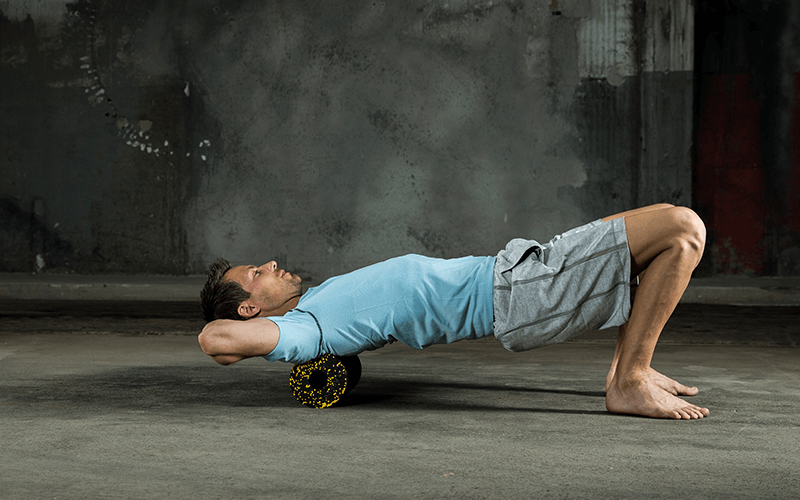
Exercise 2: Back of the leg
Stretch out one leg on the roller and support your body with your hands on the ground behind you. Now push yourself back and forth to roll along your hamstrings. Rotate your leg alternately to the left and right to access more areas of the muscles.
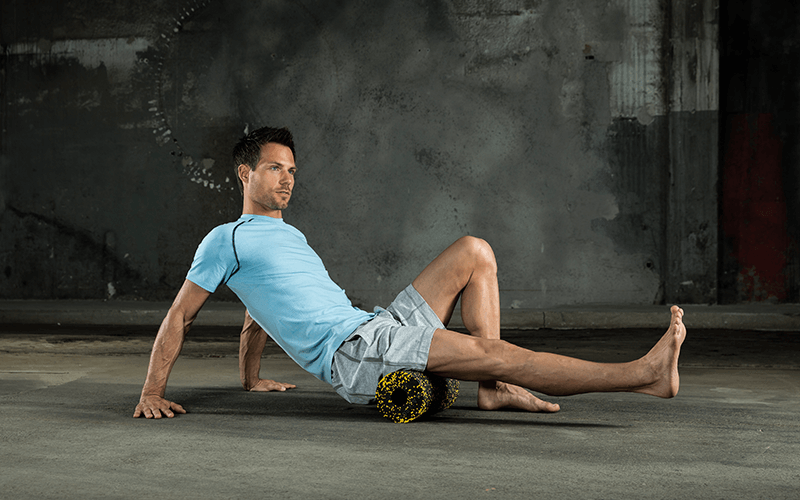
Exercise 3: Calves
Place both legs stretched out on the roller and support yourself with your hands behind you. Now push yourself forward and backward, rolling along your calf from your Achilles tendon to the back of your knee.
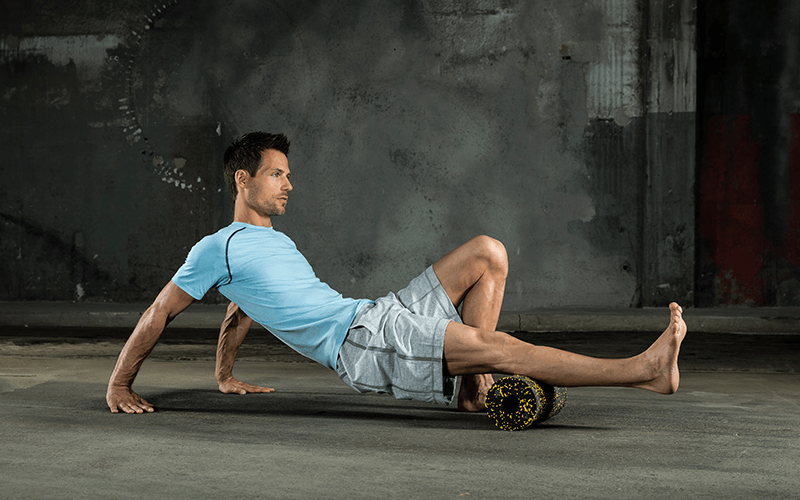
Exercise 4: Outer thigh
Lie on your side with the roller underneath your thigh. Support your body weight with your hand or elbow. Bend your upper leg and place that foot in front of your other hip. Now slowly roll until you nearly reach your knee. The advanced version: Try it with straight legs stacked on top of each other.
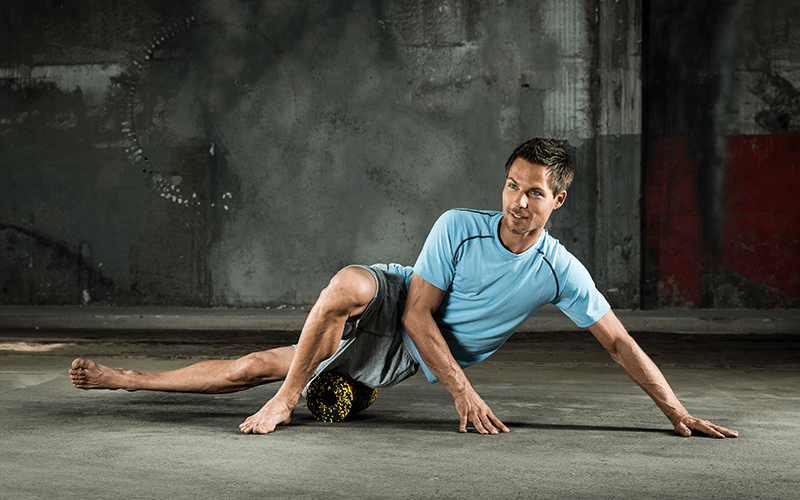
Exercise 5: Front of thigh and quads
Lie on your stomach, keeping your eyes on the floor. Support yourself on your elbows and forearms. Keep the roller under your thighs. Slide your upper body forward and backward until you’ve loosened all those muscles in the front of your thigh.
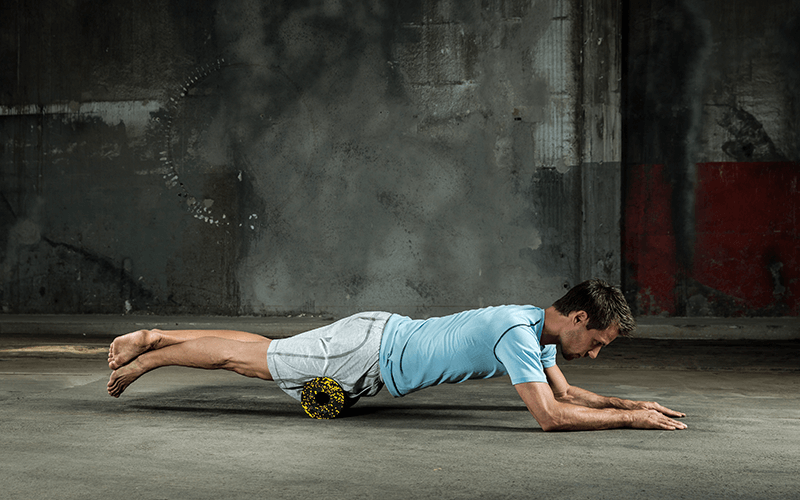
Foam Roller – How to find the right product
Not all foam rollers are created equal. There are different manufacturers, each offering foam rollers in different colors. These colors indicate the roll’s firmness. Each manufacturer can choose which color corresponds to which degree of hardness. In order to find the right fascia roll, check the specifically recommended uses before buying, and choose the roll that best suits your training condition and needs.
Look for the quality seal
Thanks to the increasing popularity of foam rolling, more and more manufacturers are entering the market. To make sure that you buy a high quality product, the rolls should be labeled with appropriate quality seals.
Summary
- Foam Rolling relaxes your muscles.
- It prevents severe muscle soreness and can help prevent injuries.
- It can be easily integrated into your daily training routine.
- You should use a foam roller regularly.
Sources for this article
We at foodspring use only high-quality sources, including peer-reviewed studies, to support the facts within our articles. Read our editorial policy to learn more about how we fact-check and keep our content accurate, reliable, and trustworthy.

































